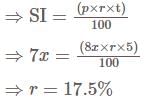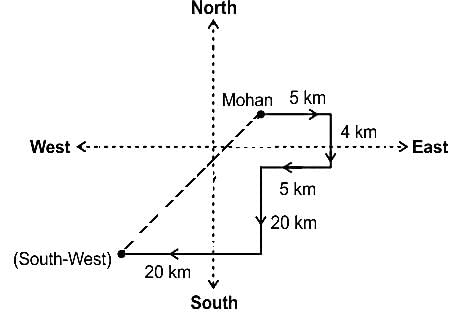CSIR NET Life Sciences Mock Test - 6 - UGC NET MCQ
30 Questions MCQ Test - CSIR NET Life Sciences Mock Test - 6
There is a digit at the 10th place of 6n, in which n is a natural number that is greater than 1, it can be:
The simple interest on some amount is 7/8 of the principal for 5 years. What is the rate (in percentage) of interest per annum?
Direction: Choose the correct alternative that will continue the same pattern and replace the question mark in the given series.


A fair had an entry fee of Rs. 1000. Later, it got reduced by 25% which in turn increased the total amount received by 20%. Find the percentage increase in the number of people entering the fair.
Mohan walks 5 meters towards East and then turns to his right, walks 4 meters and then again turns to his right and walks 5 meters. Now he turns left and walks 20 meters. He once again turns to the right and walks an additional 20 meters to reach the theater. In which direction is the theater in the context of Mohan's starting point?
Find the ratio between the students from physics and math from college A and the students from chemistry and math from college C.
Find the difference between the total number of students from the chemistry department from college B and college C and the total number of students from the physics department from college A and college D.
5 coins are tossed simultaneously. Find the probability of exactly 3 heads?
If log10(2x + 3) − 1 = log10x, then find x
Find the area of a square, one of whose diagonals is 3.8 m long.
Which of the following is known as the “window of the brain”?
KCI (100 mM ) was entrapped inside large unilamellar vesicles. A diffusion potential across the bilayer can be generated by diluting with buffer containing :
If the distance between the gene on the chromosome is more, then the gene shows _______.
Which of the following was listed as one of the vulnerable species by the International Union for Conservation of Nature?
Which of these is the primary carbon dioxide acceptor in the Hatch and Slack pathway?
Out of the following, which technique detect single nucleotide polymorphism?
Name the hormone which takes part in the release of FSH and LH from the anterior pituitary.
Seasonally breeding animals and birds measure the day length, i.e. photoperiod and use these measurements as predictive information to prepare themselves for breeding. Besides melatonin, which of the following hormones is involved in this biological process?
Early detection of a disease is possible by:
The Western honey bee (Apis mellifera) collects both nectar and pollen from flowers. The following are a few hypotheses proposed to explain this behavior in A. mellifera:
(A) In the past, those individuals that fed on both nectar and pollen left more descendants than those who preferred either nectar or pollen
(B) The sensory stimulus from taste receptors in the honey bees leads to positive reinforcement to look for more of the same food
(C) The honey bee's nervous system is predisposed to like the sweet taste
(D) The ancestor of the honey bee was dependent on some sugar and protein-rich diet and the honey bees have inherited the same taste perception
Which of the following combinations of ultimate hypotheses best explains the bee's feeding behavior?
With respect to the “tails” of the histone molecules which of the following is not true?
The inactive conformation of a G-protein coupled receptor is stabilized by ______________
Direction: In the question given below, there are two statements marked as Assertion (A) and Reason (R). Mark your answer as per the codes provided below:
Assertion (A):
In pigeons, females are heterogametic and males are homogametic.
Reason (R):
In pigeons, females have ZW sex chromosomes and males have ZZ sex chromosomes.


 Simple interest,
Simple interest,  Principle amount,
Principle amount,  Rate,
Rate,  Time
Time 

















 = 0.48x
= 0.48x


















